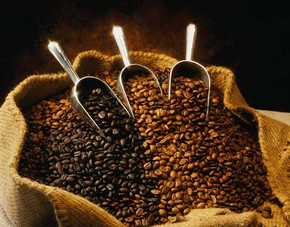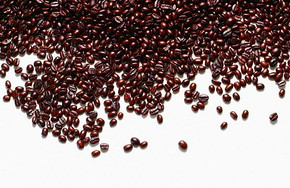Whether the roasting taste of coffee beans is correct or not, it is up to roasting.
Follow the caf é (Wechat official account vdailycom) and found that Beautiful Cafe opened a small shop of its own.
The birth of a good cup of coffee is not so easy. From the beginning of the cultivation of coffee beans, each link may influence the taste of coffee. Among them, the most important step is to bake raw and ripe. From raw to ripe, from shallow to deep, understanding the characteristics of each stage of baking is very important to control the taste of coffee in the later stage.
Raw coffee beans themselves do not have any coffee aroma, only after baking, you can smell the strong aroma of coffee. So the roasting of coffee beans is the transformation process of the internal components of coffee beans, only after roasting to produce ingredients that can release the aroma of coffee, we can smell the aroma of coffee. But in the roasting process of coffee beans, the change of composition is very complex.
However, the roasting of coffee beans directly determines the aroma of coffee beans. Poor roasting coffee, even if the raw coffee beans are very good, but also can not get very good coffee cooked beans, as a result, of course, can not make good coffee. Only with good coffee raw beans, after proper roasting, is it possible to process good coffee cooked beans, and it is also possible to provide a good prerequisite for making good coffee.
Fried coffee beans are roasted at high temperatures, or roasted, to create the coffee's unique color (similar to amber, depending on the degree of roasting), flavor and aroma. Frying turns the green (or yellowish) raw coffee beans into the familiar tea-brown coffee beans. High-quality fried roasting refers to the ingenious expression of the aroma, sour and bitter ingredients of raw coffee beans.

Technical Research
A series of chemical changes occur during the baking process. After about 5-25 minutes of baking (depending on the temperature selected), the green coffee beans lose some humidity and turn yellow. In this process, the coffee beans will swell, changing from a strong, high-density raw bean to a low-density fluffy state. After this process, the coffee beans will about double in size and begin to show a light brown after stir-frying. After this stage is completed (after about 8 minutes of baking), the calories will be reduced. The color of the coffee soon changed to dark. When the preset baking depth is reached, cold air can be used to cool the coffee beans in order to stop the baking process.
Baking is roughly divided into shallow baking (Light), medium baking (Medium), urban baking (City) and deep baking (Deep). Light roasted coffee beans: will have a strong smell, very crisp, high acidity is the main flavor and slightly mellow. Medium-roasted coffee beans: have a strong mellow, but also retain a certain degree of acidity. City-baked coffee beans: the surface is dark brown, the acidity is replaced by slight bitterness, and most of the flavor has been destroyed. Deep-roasted coffee beans: dark brown in color and oily on the surface. For most coffee beans, the alcohol content increases significantly and the acidity decreases. In fact, roasting coffee is a way of processing food, and the roasting of professional coffee is the personal expression of the roaster.
The biggest problem with first exposure to professional coffee (SPCIAITYCOFFEE) is the name of the degree of baking. For example, CITY, FULLCITY, FRENCH, ESPRESSO, etc., all produce different baking colors because of the different baking machines and producing areas. In addition, some roasting levels are named after mixed coffee: for example, ESPRESSO is a coffee with a specific roasting degree for making ESPRESSO, and even if the color looks the same, it may have a completely different flavor. Therefore, the selection of the type of beans, baking temperature and baking method, and the length of baking time are the main factors that determine the final flavor.
Stage
The roasting method of professional coffee is usually divided into the following eight stages.
1 very shallow baking (LIGHTRoast)
The degree of baking; very shallow baking, also known as shallow baking.
The lightest roasting degree of all roasting stages, the surface of the coffee beans is a light cinnamon color, its taste and aroma are insufficient, this state is almost undrinkable. It is generally used for testing and seldom for tasting.
2 shallow baking (CINNAMONRoast)
Degree of baking; shallow baking, also known as cinnamon baking.
The general baking degree, showing cinnamon color on the appearance, the smell of green has been removed, the aroma is OK, and the acidity is strong, which is a common roasting degree of American coffee.
3 Micro Baking (MEDIUMRoast)
Baking degree; moderate baking, also known as micro baking.
Medium baking heat and light baking are both American, in addition to sour taste, bitterness also appears, the taste is good. It has moderate aroma, acidity and mellowness, and is often used in the baking of mixed coffee.
4. Baking (HIGHRoast)
Baking degree; moderate micro-deep baking, also known as concentration baking.
Belongs to the moderate micro-deep baking, the baking degree is slightly stronger than the slight medium baking, the surface has appeared a little thick brown, the bitterness also becomes stronger. Coffee tastes sour and bitter, with good aroma and flavor, and is most often loved by people in Japan and Central Europe. (blue Mountain Coffee)
5 medium and deep baking (CITYRoast)
Baking degree; medium-deep baking, also known as urban baking.
The most standard degree of roasting, bitterness and acidity are balanced and are often used in French coffee. (Brazil, Colombia)
6 Deep Baking (FULL-CITYRoast)
Baking degree; micro-depth baking, also known as deep city baking.
The baking degree is slightly stronger than the medium depth, the color becomes quite dark, and the bitter taste is stronger than the sour taste. It belongs to the Central and South American baking method, which is very suitable for preparing all kinds of iced coffee.
7 very Deep Baking (FrenchRoast)
Degree of baking; deep baking, also known as French baking.
Also known as French or European baking, belongs to deep baking, the color is thick brown with black, sour taste can not be felt, especially in Europe, France is the most popular, because the fat has infiltrated to the surface, with a unique flavor, very suitable for coffee Oulei, Viennese coffee.
8 very Deep Baking (ItalianRoast)
Degree of baking; very deep baking, also known as Italian baking.
Also known as Italian baking, baking degree before carbonization, there is a scorched taste, mainly popular in Latin countries, suitable for fast coffee and cappuccino. Most of them are used in Espresso coffee series.
Coffee roasting
Baking depth meter
Baking depth appearance baking stage (the following temperature data are for reference only because of the different positions of temperature control points in different roasters)
Very shallow baking LIGHT
Light brown, before and after the first explosion, 195 to 205 degrees
Shallow baking CINNAMON
Tawny, the first explosion is over, about 205 degrees
Medium baking / micro baking MEDIUM
Brown, about 205 to 215 degrees
Medium and deep baking / city baking, CITY
Reddish brown, about 215 to 225 degrees
City-wide baking, FULLCITY
Dark brown * spot oil, about 225-230 degrees before the start of the second explosion
French baked French
Dark brown * oily surface, about 230 to 235 degrees
Italian baking is deep baking, Italian
ESPRESSO baking
Close to the black surface greasy, about 240 degrees above
Generally speaking, the darker the baking, the lower the quality. Deeper roasting means losing most of the flavor of the coffee beans.
Important Notice :
前街咖啡 FrontStreet Coffee has moved to new addredd:
FrontStreet Coffee Address: 315,Donghua East Road,GuangZhou
Tel:020 38364473
- Prev

Baking coffee is an exciting thing, not just in its color.
Following Kaiping (official Wechat account vdailycom) found that it was exciting for Beautiful Cafe to open its own small shop to bake coffee. It is reflected not only in its special color, but also in our painstaking efforts to make every coffee bean taste good. The color of baking can be imitated, but its special flavor cannot be imitated. Coffee.
- Next

Matters needing attention in drinking coffee in summer
Following Cafe comments (Wechat official account vdailycom) found that many people choose to open a small shop of their own to drink coffee in a beautiful cafe. Do you know the tips for drinking coffee in summer? Matters needing attention for drinking coffee in summer: 1. The prime time for drinking coffee is 10:00. It is best not to drink coffee early in the morning. The ideal prime time is around 10:00, after breakfast.
Related
- Beginners will see the "Coffee pull flower" guide!
- What is the difference between ice blog purified milk and ordinary milk coffee?
- Why is the Philippines the largest producer of crops in Liberia?
- For coffee extraction, should the fine powder be retained?
- How does extracted espresso fill pressed powder? How much strength does it take to press the powder?
- How to make jasmine cold extract coffee? Is the jasmine + latte good?
- Will this little toy really make the coffee taste better? How does Lily Drip affect coffee extraction?
- Will the action of slapping the filter cup also affect coffee extraction?
- What's the difference between powder-to-water ratio and powder-to-liquid ratio?
- What is the Ethiopian local species? What does it have to do with Heirloom native species?

